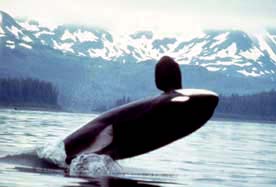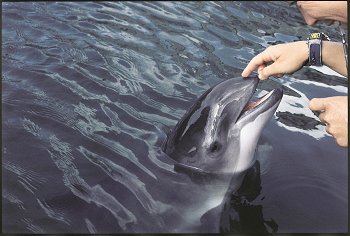Difference between revisions of "Translations:AY Honors/Marine Mammals/Answer Key/52/en"
(Importing a new version from external source) |
(Importing a new version from external source) |
||
| Line 1: | Line 1: | ||
</noinclude> | </noinclude> | ||
| − | {{: | + | {{:AY Honors/Species Account/Orcinus_orca}} |
| − | {{: | + | {{:AY Honors/Species Account/Tursiops_truncatus}} |
| − | {{: | + | {{:AY Honors/Species Account/Delphinus_delphis}} |
| − | {{: | + | {{:AY Honors/Species Account/Neophocaena_phocaenoides}} |
| − | {{: | + | {{:AY Honors/Species Account/Phocoena_phocaena}} |
Latest revision as of 20:18, 20 September 2021
Orca, or killer whale (Orcinus orca)
Where found: The orca is found in all the world's oceans, from the frigid Arctic and Antarctic regions to warm, tropical seas.
Description: The Orca or Killer Whale is the largest species of the oceanic dolphin family (Delphinidae). Orcas are versatile predators, with some populations feeding mostly on fish and others on other marine mammals, including large whales. Wild orcas are usually not considered a threat to humans.
Bottlenose dolphin (Tursiops truncatus)
Where found: The Bottlenose dolphin inhabits warm and temperate seas worldwide and may be found in all but the Arctic and the Antarctic Oceans.
Description: The Bottlenose Dolphin is the most common and well-known dolphin species. They are gray, varying from dark gray at the top near the dorsal fin to very light gray and almost white at the underside. This makes them harder to see both from above and below when swimming. The elongated upper and lower jaws form what is called the rostrum and give the animals their name of Bottlenose. The real nose however is the blowhole on top of the head, and the nasal septum is visible when the blowhole is open. Their face shows a characteristic "smile".
Common dolphin (Delphinus delphis)
Where found: The common dolphin is widely distributed in temperate, sub-tropical and tropical waters throughout the world in a band roughly spanning 40 degrees south to 50 degrees north. The species typically prefer enclosed bodies of water such as the Red and Mediterranean Seas. Deep off-shore waters and to a lesser extent over continental shelves are preferred to shallow waters. Some populations may be present all year round, others appear to move in a migratory pattern. Preferred surface water temperature is 10-28 degrees Celsius.
Description: Common dolphins travel in groups of around 10-50 in number and frequently gather into schools numbering 100 to 2000 individuals. These schools are generally very active - groups often surface, jump and splash together. Typical behavior includes breaching, tail-slapping, chin-slapping, bow-riding and porpoising.
Finless Porpoise (Neophocaena phocaenoides)
Where found: The Finless Porpoise lives in the coastal waters of Asia, especially around India, China, Indonesia and Japan. A unique fresh water population is found in the Yangtze River. At the western end, their range includes the length of the western coast of India and continues up into the Persian Gulf. Throughout their range, the porpoises stay in shallow waters (up to 50m), close to the shore, in waters with soft or sandy seabeds. In exceptional cases they have been encountered as far as 100 miles off-shore in the East China and Yellow Seas, albeit still in shallow water.
Description: The Finless Porpoise almost completely lacks a dorsal fin. Instead there is a low ridge covered in thick denticulated skin. Adult Finless porpoises are a uniform light grey color. Infants are mostly black with grey around the dorsal ridge area, becoming grey after 4-6 months.
Harbour Porpoise (Phocoena phocaena)
Where found: The Harbour Porpoise, as its name implies, stays close to coastal areas or river estuaries and as such is the most familiar porpoise to whale watchers. This porpoise often ventures up rivers and has been seen hundreds of miles from the sea.
Description: The Harbour Porpoise is a little smaller than the other porpoises. It is about 75 cm long at birth. Males grow up to 1.6 m and females to 1.7 m. The females are correspondingly heavier, with a maximum weight of around 76 kg compared with the males' 61 kg. The body is robust and the animal is at its maximum girth just in front of its triangular dorsal fin. The beak is poorly demarcated. The flippers, dorsal fin, tail fin and back are a dark grey. The sides are a slightly speckled lighter grey. The underside is much whiter, though there are usually grey stripes running along the throat from the underside of the mouth to the flippers.




